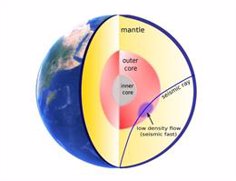July 1 () –
A 15-year study led by the Carnegie Institution for Science details the origins and the diversity of all known minerals on Earth.
According to its authors, this is a landmark work that will help reconstruct the history of life on Earth, guide the search for new minerals and deposits, and predict the possible characteristics of future life and to facilitate the search for habitable planets and extraterrestrial life.
In two articles published in the magazine ‘American mineralogist‘ and sponsored in part by NASA, Carnegie scientists Robert Hazen and Shaunna Morrison detail a novel approach for grouping related species of minerals or separating new species based on when and how they originated.
Once the genesis of minerals is taken into account, the number of “mineral types” — a newly coined term — amounts to more than 10,500, a figure that exceeds by 75% the approximately 6,000 mineral species recognized by the International Mineralogical Association (IMA) based solely on crystal structure and chemical composition.
“This work fundamentally changes our view of the planet’s mineral diversity,” said Dr. Hazen, a scientist in the Earth and Planets Laboratory at the Carnegie Institution for Science.
“For example, more than 80% of minerals on Earth were mediated by water, which is therefore fundamentally important for mineral diversity on this planet,” he explains. “By extension, this explains one of the reasons key by which the Moon and Mercury, and even Mars, they have far fewer mineral species than Earth.”
“The work also tells us something very profound about the role of biology,” he adds. “A third of the minerals on Earth could not have formed without biology: shells and bones and teeth, or microbes, for example, or the vital indirect role of biology, like creating an oxygen-rich atmosphere that gave rise to 2,000 minerals that wouldn’t have formed otherwise.”
According to the article, nature created 40% of the Earth’s mineral species in more than one way — for example, both abiotically and with the help of cells — and in several cases used more than 15 different recipes to produce the same crystal structure and chemical composition.
Of the 5,659 mineral species recognized by Hazen and his colleagues, nine arose through 15 or more different physical, chemical, and/or biological processes, from near-instantaneous formation by lightning or meteor strikes to changes caused by the interactions between water and rock or the transformations at high pressures and temperatures that span hundreds of millions of years.
To reach their conclusions, Hazen and Morrison built a database of all known formation processes for all known minerals. Drawing on large open access mineral databases (mindat.org and rruff.ima/info), augmented by thousands of primary research articles on the geology of mineral localities around the world, identified 10,556 different combinations of minerals and modes of formation.
In previous studies spanning more than a century, thousands of mineralogists around the world have painstakingly documented nearly 6,000 different “mineral species” based on their unique combinations of chemical composition and crystal structure. Dr. Hazen and his colleagues took a different approach, focusing on how and when each type of mineral appeared over more than 4.5 billion years of Earth’s history. “No one had ever undertaken this enormous task before,” Hazen says.
The study concludes that water has played a dominant role in the Earth’s mineral diversity, since it has participated in the formation of more than 80% of mineral species.
Life played a direct or indirect role in the formation of almost half of the known mineral species, while a third of the known minerals – more than 1,900 species – they were formed exclusively as a consequence of biological activities.
Furthermore, rare elements play a disproportionate role in the Earth’s mineral diversity. Only 41 elements – which together constitute less than 5 parts per million of the earth’s crust – are essential constituents in about 2,400 (more than 42%) of the Earth’s minerals, and much of Earth’s mineral diversity was established in the planet’s first 250 million years.
Some 296 known minerals are believed to predate the Earth itself, of which 97 are only known from meteorites (with the age of some individual mineral grains estimated at 7 billion years, i.e. billions of years before the origin of our solar system).
According to the study, the oldest known minerals are tiny and durable zircon crystals, dating back nearly 4.4 billion years. At the same time, more than 600 minerals have been derived from human activities, including more than 500 minerals caused by mining, 234 of them formed by fires in coal mines.
According to the research, it is known that 3,349 (59%) of the mineral species approved by the IMA come from a single process (paragenic mode), 1,372 species (24%) from two processes, 458 (8%) from three processes and the rest, 480 (8%), of four or more processes.
The articles detail other considerations on the grouping and classification of minerals, such as the eon in which they were formed. Y
It also appears that hundreds of different minerals may have formed on Earth before the giant impact that vaporized much of the planet’s crust and mantle and led to the formation of the Moon some 4.5 billion years ago. If so, those minerals were erased, to reform when the Earth cooled and solidified.
In addition to accidental mineral creations in mine fires, mankind has manufactured countless thousands of mineral-like compounds that do not qualify for IMA recognition: building materials, semiconductors, laser crystals, special alloys, gemstones. synthetics, plastic remains and the like. All of them, however, are “likely to persist for millions of years in the geological record, thus providing a clear sedimentary horizon that marks the so-called ‘Anthropocene Epoch'”.
Meanwhile, there are 77 “biominerals,” according to the paper, formed by a variety of metabolic processes, from corals, shells and nettles, to minerals in bones, teeth and kidney stones.
Another 72 minerals come directly or indirectly from the guano and urine of birds and bats. That list includes the rare mineral spheniscidite, which forms when the urine of penguins (order Sphenisciformes, hence the mineral’s name) reacts with clay minerals under a rook colony on Elephant Island, in the British Antarctic Territory.
The authors note that the formation of the oceans, the extensive development of continental crust, and perhaps even the initiation of some early form of subduction (the process that drives plate tectonics today) in the early Hadean Eon, between 4,000 and 4,500 million years ago, it meant that many important mineral formation processes -and up to 3,534 mineral species- occurred in the first 250 million years of the Earth.
The work also points the way for future researchers and explorers on what mineral-forming environments occur on the Moon, Mars, and other worlds.













![[Img #73262]](https://thelatestnews.world/wp-content/uploads/2024/07/The-era-of-artificial-intelligence-in-digital-marketing-in-Spain-300x200.jpg)
Add Comment